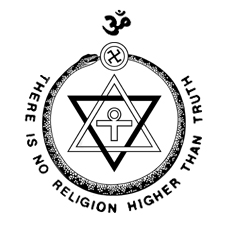The Count of St. Germain | |
|---|---|
| Comte de Saint Germain | |
 Engraving by Nicolas Thomas, 1783 (based on a painting then owned by Jeanne Camus de Pontcarré and now lost[1]); , contained at the Louvre[2] | |
| Born | 1691 or 1712 |
| Died | 27 February 1784 |
| Other names | Marquess of Montferrat (Fr. Marquis de Montferrat), Count Bellamarre (Fr. Comte Bellamarre), Knight Schoening (Fr. Chavelier Schoening), Count Weldon, Count Soltikoff (Fr. Comte Soltikoff), Manuel Doria, Graf Tzarogy, Prince Ragoczy (Ge. Prinz Ragoczy) |
| Part of a series on |
| Theosophy |
|---|
 |
The Count of St. Germain (French: Comte de Saint Germain; French pronunciation: [kɔ̃t də sɛ̃ ʒɛʁmɛ̃]; c. 1691 or 1712 – 27 February 1784)[3] whose real name and origins remain unknown, was a European adventurer who had interests and achievements in science, alchemy, philosophy, and the arts. He rose to prominence in the European high society of the mid-18th century due to his works and interests. He associated himself with some of the top contemporary figures of the time, including Casanova, Voltaire and Mozart.
The count used a variety of names and titles, including the Marquess of Montferrat (Fr. Marquis de Montferrat), Count Bellamarre (Fr. Comte Bellamarre), Knight Schoening (Fr. Chevalier Schoening), Count Weldon, Count Soltikoff (Fr. Comte Soltikoff), Manuel Doria, Graf Tzarogy, and Prince Ragoczy (De. Prinz Ragoczy). He appears to have begun to be known under the title of the Count of St Germain during the early 1740s.[4]
He is said to have made far-fetched claims (such as being 500 years old),[5] leading Voltaire to dub him "the Wonderman", and that "he is a man who does not die, and who knows everything".[6][7] Charles, the prince of Hesse-Kassel, is recorded as having called him "one of the greatest philosophers who ever lived".[8]
- ^ "The Count of St. Germain", Johan Franco, Musical Quarterly (1950) XXXVI(4): 540-550
- ^ Hall, Manley P. (preface) The Music of the Comte de St.Germain Los Angeles: Philosophical Research Society, 1981
- ^ Isabel Cooper Oakley, p45
- ^ Chrissochoidis, Ilias. "The Music of the Count of St. Germain: An Edition" (PDF). Retrieved 8 February 2024.
- ^ Oliver, George (1855). A Dictionary of Symbolic Masonry: Including the Royal Arch Degree; According to the System Prescribed by the Grand Lodge and Supreme Grand Chapter of England. Jno. W. Leonard. p. 10.
- ^ "Comte de Saint-Germain | Britannica". Encyclopædia Britannica. Retrieved 25 January 2023.
- ^ Frederick II. "Correspondance avec M. de Voltaire." Oevres Posthumes de Frederic II. Tome XIV. Amsterdam, 1789. Pages 255 - 257
- ^ S. A. Le Landgrave Charles, Prince de Hesse, Mémoires de Mon Temps, p. 135. Copenhagen, 1861.